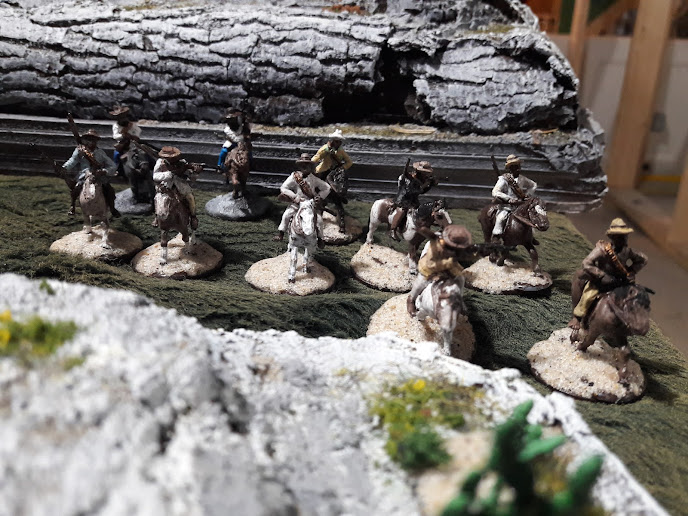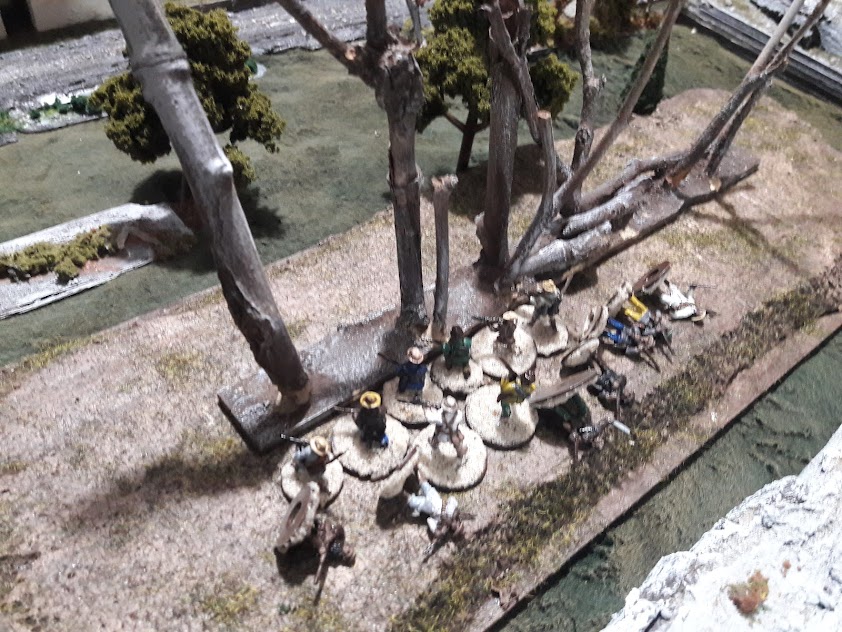Hi all, here is an AAR for Scenario 11: The Liberation of Sinoquipe, Sonora, April 27, 1911.



The political and economic leadership of Sinoquipe were stationed in the building behind them.
The defenders were all set behind their lines, awaiting the arrival of the PLM rebels.
The rebels arrived in the south-west corner of the table. It was a large force, with two cavalry groups, and two infantry groups each of workers and peasants, Yaqui rebels, and mutinous Federal soldiers.
From his headquarters at the top of the mountain, Florencio Jaramillo organized the attack.
Two sections of Indigenous infantry headed to the northern ridge of the mountain, to cover the advance of their cavalry toward the western road.
Jaramillo ordered the other cavalry section and an infantry group to charge the southern line, but they both failed to find the courage to run out into the open.
The Liberals moved up the group of mutinous soldiers and another infantry group, with orders to charge into the town.
On the second turn, Jaramillo's cavalry group finally took off. They tried to use the trees as cover as they raced toward the southern defensive line.
The soldiers defending Sinoquipe fired on the horsemen, causing the first casualties of the battle.
On the mountain above them, the Liberal assault groups prepared to descend into the town.
On the western edge of the table, one of the Yaqui infantry sections joined the cavalry to push north and cut the western road.
At the start of the third round, the revolutionary cavalry in the southern trees continued to attack the soldiers defending the barricades. The rebels landed a few hits, but the government's machine gun on the roof, and their many well-trained rifles, killed half of the riders and forced the survivors to flee.
While they withdrew, the Yaqui section on the western flank continued to march. Using the hills as cover, they neared the western road. They had orders to engage the strongpoint at the crossroads and attempt to take out the machine gun, which had a clear line of vision straight down the main highway.
The cavalry charge having failed, Jaramillo needed a new plan for crossing that road and attacking the southern line. He sent a platoon of uniformed, Federal soldiers--whom had recently defected to the revolution--down the slope, to see if they could just march into town. The ruse worked. The defectors got within feet of their enemies without incident.
Inside the town, the Rurales in the plaça, having heard the exchange with the cavalry, moved into defensive positions. The townsfolk, however, continued to mill about on the streets. A few shots had sounded earlier, but until now, the day was largely quiet.
On the next turn, the rebellious soldiers broke the silence. Firing first, they destroyed the squad of soldiers guarding the corner of the line. The loyal soldiers killed a couple mutineers, but the lone survivor fled toward the rest of his platoon.
The rebel soldiers moved into the town and took cover behind the first building. Federals fired at them from within the town, and the machine gun to their right turned to fire down on them. They took few casualties, but had many soldiers pinned.
Rurales and soldiers fired on the rebels from behind a church and the other buildings of the plaça.
Meanwhile, the Yaqui infantry group reached their positions, and took cover behind a stand of trees and some fallen logs.
They fired on the barricades across the road, killing a few of the defenders.
On the south end of the table, the survivors of the rebel cavalry group which attempted a charge earlier, and two infantry sections, followed the defecting soldiers into Sinoquipe.
The government's machine gun section killed a few of the revolted soldiers, but rebels are now pouring into the southern part of Sinoquipe. The gun crew saw no other option, abandoned their weapon and fled toward the center of town.
At the crossroads, however, the other machine gun crew train their weapon on the insurgents crossing their sightline.
Four rebels fell in the street, but the rest of the insurgent infantry disappeared behind the buildings of Sinoquipe.

On the next turn, the infantry advanced toward the plaça, and captured a couple buildings toward the center of town. The cavalry arrived across the river, though the lead rider fell to some rifle fire from the church.
On the other end of the line of contact, the Yaqui infantry section continued to pick off soldiers behind their sandbags. They caused enough casualties that the defenders of the westernmost barricade abandoned their post and fled into the L-shaped building.
The remaining soldiers returned fire, however, with deadly accuracy. Three Yaqui fell, but the group held their places.
In the next turn, more Yaqui riflemen moved up to fire on the enemy. The indigenous cavalry also unloaded their rifles before galloping north. More defenders fell, and the survivors of the soldiers' platoon fled into the building.
The machine gun crew, however, kept their wits about them. They turned their machine gun at the insurgents on the wooded hill, and fired.
Four insurgents fell. Their comrades refused to flee, however, and consolidated their lines to return fire.
Across the river, the rebel cavalry crossed the agricultural fields, and attempted to turn the right flank. Soldiers fired down at them from the windows and roof of the church.
Behind them, the rebels continued to advance into the town, and rebellious soldiers climbed up onto the concrete building to take over the abandoned machine gun.
Across the road, the second Yaqui infantry group came down out of the mountain and joined their comrades in the trees.
With reinforcements arriving, the survivors of the first infantry group advanced across the western road, and occupied the barricades they had previous fired at. Now, they had a clear line of fire on the machine-gun position.
With a round of bullets from their rifles, and the Yaquis killed the machine gun crew.
Further up the left side of the table, the Yaqui cavalry reached the northern edge. With the attack progressing as intended and the sounds of battle drawing nearer, the riders looked for suitable positions to block any escape routes out of town.
Right on cue, the military commander of Sinoquipe made the decision to evacuate. He ordered the political and economic leaders and his headquarters section to prepare to leave the town. He could have no idea about the enemy horsemen behind him.
Meanwhile, the remaining Federal soldiers and Rural officers continued to defend the center of the town. They fired at the rebel lines from the church roof, behind the farm equipment and around the corners of the buildings.
The revolutionary soldiers in their uniforms fired back at their former compatriots, slowly advancing toward the square.
Meanwhile, the survivors of the government defensive positions at the cross roads huddled in a nearby building, awaiting the expected push from the attackers in the hills.
The second Yaqui infantry group ran down out of the trees to capture the barricades. The soldiers in the building fired out on them, desperate to halt the advance and save the town.
Ahead of the Yaqui infantry, a couple of horsemen waited on the hill by the highway, while the rest of the group stood behind a stone farm wall.
Back in town, the revolutionaries continued to push toward the plaça, now under the cover of a captured machine gun, expertly handled by rebellious soldiers beneath the red flag.
The town's defenders held strong around the church, but the insurrectos' machine gun killed the Rurales officers behind the tractor.













































































No comments:
Post a Comment